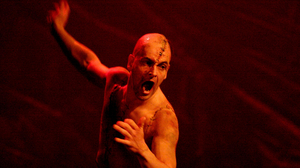Review: FRANKENSTEIN, National Theatre At Home

![]() Back in 2011, it was nigh-on impossible to get a ticket for the National Theatre's production of Frankenstein. You may be forgiven for thinking the fact that Danny Boyle was directing the show was enough of a draw, but the news that Jonny Lee Miller and Benedict Cumberbatch were not only starring in it, but also alternating the roles of Frankenstein and The Creature, sent fans into a frenzy. As part of the hugely successful run of National Theatre At Home shows, we are now gifted with seeing both versions again.
Back in 2011, it was nigh-on impossible to get a ticket for the National Theatre's production of Frankenstein. You may be forgiven for thinking the fact that Danny Boyle was directing the show was enough of a draw, but the news that Jonny Lee Miller and Benedict Cumberbatch were not only starring in it, but also alternating the roles of Frankenstein and The Creature, sent fans into a frenzy. As part of the hugely successful run of National Theatre At Home shows, we are now gifted with seeing both versions again.
The dark and Gothic horror of Mary Shelley's 1818 novel is very difficult to convey on stage without either veering to cartoonish horror or missing the crucial questions about science, society and patriarchy that Shelley conveys in her writing. Danny Boyle has created a brilliantly haunting production that follows the start of book as The Creature is born: a horrifying creation by obsessive scientist Dr Victor Frankenstein, made by assembling disparate body parts. Disgusted by what he has forged, Frankenstein casts out The Creature.
The focus of Nick Dear's highly intelligent adaptation then shifts; it is not so much about the moral debates and endeavours of Victor Frankenstein, but follows the sad situation of The Creature. We see the painful transition from staggering steps to a desperate need for love and acceptance. Miller's very physical version of The Creature is charged with danger and menace. From the moment he bursts from the womb-like space at the centre of the stage; naked, with his body in spasm, Miller creates a character that manages to be both hideous and also highly sympathetic.
Society's focus on his gruesome appearance makes the world a place of constant rejection for him. He sees no kindness or compassion, and so it is unsurprising that he learns nothing but hatred and anger. The one moment where he is shown any sympathy is by blind De Lacey (played with a gentle kindness by Karl Johnson), who cannot see his physical flaws. Miller adeptly conveys the gradual crushing of any spirit The Creature may have had if the world had shown him more compassion.
Benedict Cumberbatch is compelling to watch as the icy-hearted scientist. It is easy to see his disgust and repulsion at his creation, and the audience sees this is comfortable territory for Cumberbatch as a highly intelligent and aloof man. It is also a role that seems to have less depth than that of The Creature; his brilliance as a scientist creates his arrogance and obsession, but the character arc suffers a little due to the huge concentration on the mind of The Creature.
The production does not allow for much in the way of story development involving any other character. The De Lacey family appear rather fleetingly, and Naomie Harris is calm and sensitive in the underused role of Elizabeth, Victor's fiancée. However, this allows the time to be concentrated on the scenes where the two lead actors are on stage together and these are the most electric. When The Creature begs passionately for a female companion, there is a clear sense of Frankenstein's hatred for him, coupled with an incredulity that he could have dreamt up such an idea.
Although muted by the necessity to see this on a screen, Mark Tildesley's design is nevertheless visually striking, from the red membrane from which The Creature collapses onto the stage, to the steam train that chugs onto the stage. Bruno Poet's lighting is stunning, particularly the visceral flashes of electrical energy as The Creature is born and the thousands of bulbs lit above the stage. The icy landscape of the Arctic is luminous and desolately beautiful.
This is a visceral and haunting production. By alternating the roles of Frankenstein and The Creature, Boyle suggests that the characters are interchangeable - the two sides of the same person. It also highlights the central theme of role reversal: how the master becomes the slave and the slave the master.
To compare the interpretations of the roles and to see the full impact of this concept, you need to see both versions of the production. How fortunate that the National Theatre has given us all that opportunity.
Frankenstein is available on the National Theatre's YouTube Channel until 8 May
Read our review of the other Frankenstein production here
Photo Credit: Catherine Ashmore
Reader Reviews
Videos


